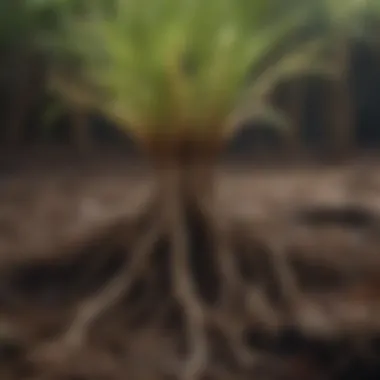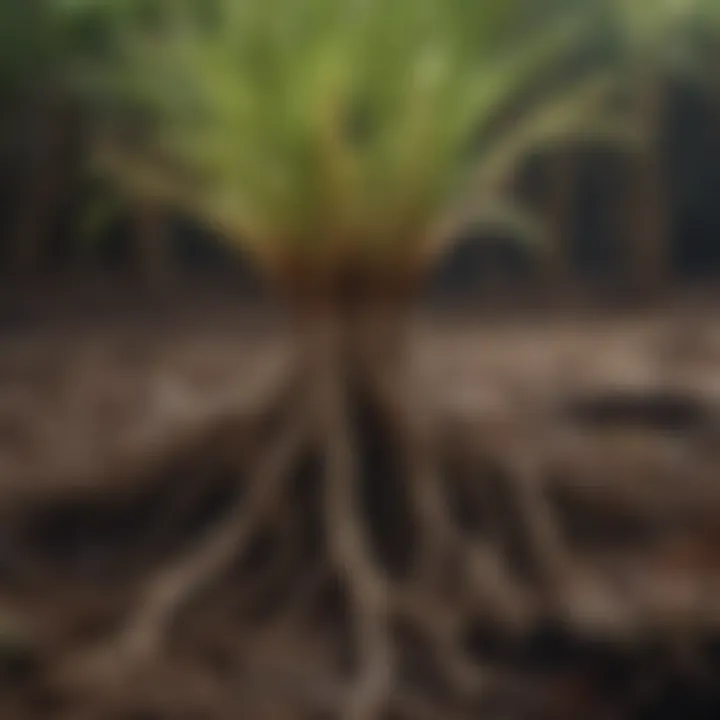The Relationship Between Water Quality and Plant Health


Intro
Understanding the relationship between water and plant health is a crucial aspect of successful gardening. It’s not just about giving plants a drink, but rather about recognizing the intricate web of interactions that water has with plant systems. The implications of water quality, availability, and management can make the difference between a thriving garden and a struggling one. As we explore this topic, we will uncover how proper water management influences plant vitality and what practical steps can be adopted by both casual gardeners and seasoned horticulturists.
Many may think watering their plants is straightforward, but the interplay of water with plant physiology is quite complex. Water doesn’t simply hydrate plants; it plays a vital role in the absorption of nutrients, photosynthesis, and even in fighting diseases. A poor understanding of this relationship can lead to over-watering or under-watering, both of which can compromise plant health.
This article will delve into the different nuances associated with water and plant life, discussing water quality, optimal watering techniques, and environmental factors that impact water usage. Each section will arm you with practical knowledge designed to elevate your gardening endeavors and ensure your plants flourish.
Whether you're tending to a humble pot of herbs or managing a sprawling vegetable garden, the relationship between water and plant health is something that cannot be overlooked.
Understanding Plant Water Requirements
When delving into the topic of plant health, comprehending water requirements is paramount. Water is the lifeblood of plants, serving not just as an essential nutrient but also as a medium through which nutrients are transported throughout the plant's system. Without adequate water, plants can suffer stress, exhibit stunted growth, or even die. Therefore, understanding the water needs of various plants is crucial for anyone looking to cultivate a healthy garden or landscape.
Water plays a multifaceted role in plant health. It regulates temperature, aids in photosynthesis, and is crucial for nutrient uptake. Beyond mere survival, the right amount of water can mean the difference between a flourishing garden and a wilted patch. Factors such as soil type, plant type, and climatic conditions all intertwine to create a unique water profile for every gardening scenario, emphasizing the need for customized watering strategies.
The Basics of Plant Water Needs
At the crux of plant water needs are a few basic principles. Most plants require consistent moisture, but not all plants thrive on the same quantity. Some thrive in wet soils, such as ferns, while others, like succulents, prefer the drier side of life. Generally, it's crucial to maintain a balance. Too little water and the plant may wilt; too much and you risk creating conditions that can lead to root rot.
When watering, it’s often better to water deeply and less frequently. This encourages deep root growth, allowing plants to access moisture stored deeper in the soil. A quick splash of water doesn't do much in fostering strong, healthy plants. Instead, a thorough soaking encourages roots to stretch down, enhancing the overall stability and health of the plant.
Factors Influencing Water Needs
Several factors come into play when determining how much water a plant needs. Here are some central elements:
Plant species variations
Different plant species have evolved unique adaptations regarding water retention and usage. For instance, the striking desert cactus stores water in its fleshy tissues, allowing it to thrive in arid conditions. Conversely, lush tropical plants often demand high moisture levels. This variation means that understanding the specific requirements of your plants can lead to healthier and more resilient specimens. Notably, utilizing local flora, which often flourishes in similar conditions, can yield significant advantages in terms of maintenance and sustainability.
Soil composition
Soil composition is a significant determinant in a plant's water necessity. Sandy soils drain quickly, requiring more frequent watering, while clay soils retain moisture, which can lead to pooling or even root issues if not managed correctly. Healthy soil is often a blend, offering both drainage for air and moisture retention. Amending your soil with organic matter can improve its structure and enhance its ability to hold water, thereby supporting better plant health and growth.
Climate and weather conditions
Climate and weather have a direct impact on water needs. Plants in hot, dry climates often need more water than those in cool, humid regions. Recognizing shifts in seasons, such as an unexpected drought or heavy rainfall, helps in adjusting watering habits proactively. Understanding local weather patterns and climate allows for better planning and adaptation. For example, if your area typically sees a dry spell, implementing mulch around your plants can reduce evaporation and maintain soil moisture effectively, making your gardening efforts more sustainable.
"Water management is half the battle when it comes to plant health. The other half is knowing your environment and making adjustments accordingly."
Successful gardening hinges on a solid foundation of understanding the intricate relationship between plant water requirements and their overall health. The more attuned you become to these factors, the better your plants will thrive.
The Role of Water in Plant Physiology
Water is the lifeblood of plants, a critical component that governs numerous physiological processes essential for their survival and development. In exploring the intricate interactions between water and plant health, it's vital to recognize how water influences everything from photosynthesis to cooling mechanisms.
Understanding the role of water in plant physiology isn’t just a botanical curiosity; it's essential for anyone passionate about horticulture. By delving into the dynamics of how water functions within a plant, homeowners and gardening aficionados can cultivate healthier plants and more bountiful gardens.
Photosynthesis and Water
At the core of plant nutrition lies photosynthesis, a process that transforms sunlight into energy. Water serves as one of the foundational elements in this wondrous mechanism, feeding the plant with essential hydrogen atoms. Through the roots, water travels to the leaves where it mixes with carbon dioxide absorbed from the air. This mix reacts under sunlight to produce glucose and oxygen, the latter being released back into the atmosphere.
What’s remarkable is that every single leaf functions like a tiny factory, relying on a consistent supply of water to maintain productivity. Inadequate water can severely stunt this process, resulting in a host of problems, from stunted growth to reduced yields. Therefore, ensuring a reliable water supply isn’t just important; it’s a must for anyone wanting to watch their plants flourish.
Transpiration and Its Importance
Transpiration stands out as another key aspect of how water operates within plants. This process involves the movement of water vapor from inside the plant, primarily through the stomata—tiny openings located on leaves. Transpiration plays several critical roles in plant health and surroundings:
Cooling Mechanisms
Transpiration acts as a natural cooling system. As water evaporates from the leaf surfaces, it cools the plant down much like perspiration cools the human body. This is particularly crucial during hot weather when high temperatures can stress plants. Plants equipped with healthy transpiration processes are better positioned to handle heat stress, contributing to overall vitality. The key characteristic of this cooling mechanism is that it helps regulate internal temperatures and minimizes damage from heat, making it a beneficial choice for every plant enthusiast.
Moreover, this process helps maintain moisture in the surrounding air, creating a micro-climate conducive to plant growth. The unique feature of transpiration is how it continuously draws water from roots to leaves, keeping everything in balance. The advantage of this mechanism is evident during heatwaves, when it helps mitigate temperature peaks, benefitting both the plant and nearby ecosystem. However, excessive transpiration, especially in drought conditions, can lead to complications, so gardeners need to be wary.
Nutrient Absorption
Water is also a carrier for essential nutrients absorbed by plants. Through capillary action within the soil, nutrients need to travel with water into the roots where they are then distributed throughout the plant. Without adequate water, these nutrients can't be effectively mobilized, leading to deficiencies that could manifest as stunted growth or poor foliage.
In terms of nutrient absorption, the key characteristic lies in its ability to dissolve various minerals, making them accessible to plants. This feature justified why water is a must-have for anyone aiming for lush green spaces. The unique advantage of this system is its efficiency; a well-watered plant not only receives hydration but also an array of nutrients necessary for growth. However, if the water is contaminated or of poor quality, this can hinder growth and lead to toxicity.
In summary, the role of water in plant physiology is multifaceted. Its contributions to photosynthesis and transpiration illustrate how crucial it is for nutrient exchange and temperature regulation. Understanding these processes empowers gardeners to make informed decisions, ultimately leading to healthier and more vigorous plants.
Water Quality: Impact on Plant Health
Water quality is a cornerstone of plant vitality. It's not just about the amount of water; it's also about what’s in that water. Quality influences not only how plants grow but also their resilience against disease and pests. Poor water quality can stress plants, making them more vulnerable to issues.


Understanding pH Levels
The pH level of water can dramatically affect nutrient uptake. Most plants thrive in a slightly acidic environment, usually between 6.0 and 7.0. However, if the pH swings too high or too low, essential nutrients become locked away. For example, in alkaline conditions, iron, a vital nutrient, becomes less available, potentially leading to deficiencies. Therefore, monitoring pH levels is crucial for maintaining a flourishing garden.
Contaminants Affecting Plant Growth
Contaminants in water can severely hinder plant health. It's crucial to recognize what these contaminants are and how they influence growth.
Chlorine and Fluoride
Chlorine, often used in municipal water systems, serves as a disinfectant. While it helps keep pathogens at bay, it can also harm beneficial soil microorganisms. That being said, some plants can tolerate it better than others. Choosing the right species can make it a less controversial choice for gardeners. Fluoride, on the other hand, while good for human dental health, can cause leaf tip burn in sensitive plants. Finding a balance is essential; sometimes letting tap water sit out for a day can help dissipate the chlorine.
Heavy Metals
Heavy metals like lead and cadmium can infiltrate water sources from industrial runoff or old pipes. These elements are toxic to plants, affecting their ability to absorb nutrients and water. The presence of heavy metals in water often stems from human activity, making it imperative to test water quality in areas where pollution is more likely. On the flip side, certain hyperaccumulator plants can extract these metals from the soil, offering a form of bioremediation. However, relying on them means careful management of both soil and water to avoid harm to the plants and the broader ecosystem as well.
"The health of your plants starts from the ground up… or rather, from the water down!"
Understanding these factors is integral for creating a sustainable and productive garden. Ensuring that your water quality is up to snuff can spell the difference between a thriving oasis and a wilting landscape.
Sources of Water for Plants
Whenever gardeners and horticulturists ponder about plant vitality, seldom do they consider the fundamental anchor of plant health: water. In this section, we delve into the various sources of water that plants draw upon, examining how each uniquely contributes to their overall wellbeing. From the refreshing gentleness of rainwater to the resilient reliability of tap water, understanding these sources is critical for nurturing thriving gardens.
Rainwater Harvesting
Rainwater harvesting is a practice that has gained momentum among eco-conscious gardeners. Collecting rainwater helps in conserving a precious resource while providing plants with nutrient-rich hydration. Not only does it minimize reliance on municipal water supplies, but it also allows for direct use in irrigation systems and reduces stormwater runoff.
Benefits and limitations
One of the central benefits of rainwater harvesting lies in its eco-friendliness. Utilizing rainwater is effectively a free source of irrigation for your plants. It's particularly beneficial for those in areas prone to drought, where every drop counts.
However, there are limitations as well. For example, the varying amounts of rain throughout the seasons can make rainwater harvesting unpredictable. A particularly dry spell might leave you high and dry. Additionally, one must manage potential contaminants that can come off roofs or collect in storage systems, rendering the water less suitable for sensitive plant species.
"Every drop counts, especially when it comes to nurturing our green friends."
Collection and storage methods
When it comes to collection and storage, the right approach can make a world of difference. Rain barrels are a popular choice, as they can be easily set up under downspouts to catch the falling rain directly. Storage tanks are another option, often offering larger capacities. It's key, though, to ensure they are covered to prevent mosquito breeding and algae growth.
But even with the best barrels, neglecting regular cleaning can lead to ineffective water capture. Flavor changes in the water can occur if sediments settle, which might not be ideal for all plants. Hence, maintaining clean collection systems is where your diligence comes into play.
Tap Water vs. Natural Sources
This is a long-standing debate in gardening circles: tap water versus natural sources such as rivers and lakes. On one side, tap water provides consistent access and is often treated to remove harmful pathogens. However, it might contain additives like chlorine or fluoride which can be detrimental to certain delicate plants.
Natural water sources might seem ideal due to their lack of chemicals. But they come with their own set of risks, including pollutants from nearby areas which can introduce unwelcome surprises to your irrigation routine. Assessing the quality of both sources is a must when determining the best option for your urban oasis or backyard sanctuary.
Each source of water carries its own benefits and challenges, and the choices one makes can significantly impact plant growth. Making informed decisions leads to thriving plants and sustainable gardening practices.
Optimal Watering Techniques
In gardening, getting the watering techniques right is akin to finding the key that unlocks a door to thriving plant health. Watering techniques can be the difference between a lush garden and a parched landscape. Understanding how to effectively manage watering can greatly influence a plant's ability to absorb nutrients, develop strong roots, and resist diseases. Furthermore, improper watering can lead to wastage of water resources, impacting both the environment and the wallet. Whether you’re a seasoned gardener or just someone planting a few herbs in the backyard, this section offers important insights to ensure your plants stay healthy and happy.
Soil Moisture Management
Using moisture meters
Using moisture meters can transform the way gardeners approach watering. These handy tools provide a real-time understanding of moisture levels in the soil, meaning you won’t have to guess when it’s time to water. The basic principle of a moisture meter is to indicate when your soil is dry enough to warrant watering, using a simple scale.
One significant characteristic of these devices is their accuracy. With a moisture meter, you get precise readings that help you avoid both over and under-watering. Nobody wants to drown their plants—nor do they want them to desperately seek water. The unique aspect of using moisture meters is the way they simplify the process. Instead of relying on intuition or those age-old finger-in-the-soil tricks, a moisture reader tells you straight up when it’s time to water.
"Using a moisture meter means you can trust the data instead of just your instincts. It’s like having a little gardening buddy who always gives you the right advice!"
Of course, there can be downsides. Some meters can break easily or need calibration. Different soil types may also affect readings differently. But in general, it's a beneficial choice for keeping your plants in the pink.
Signs of over and under-watering
Spotting the signs of over and under-watering is an essential skill for any gardener. Over-watering is often detected through yellowing leaves or root rot, while under-watering may show in drooping stems and dry, crispy leaves. These indicators serve as vital clues, allowing gardeners to act before it’s too late.


One key characteristic of recognizing these signs is the ability to adapt your watering rhythm. Understanding the symptoms can provide valuable feedback on how well your watering techniques align with your plants' needs. The unique feature of being attentive to these signs is it makes you proactive rather than reactive. Catching a problem early means you can fix it without a major loss of plant health.
However, some may find it difficult to distinguish between symptoms of over-watering and other pests or disease issues. Misreading can lead to more problems if a gardener starts making changes based on incorrect assumptions. Striking a balance is crucial for ensuring optimal growth.
Irrigation Systems Overview
Drip irrigation systems
Drip irrigation systems offer a meticulous approach to watering, by delivering water directly to the plant roots through a network of tubes and emitters. This method reduces waste and ensures that each plant receives a precise amount of water.
A key characteristic of drip irrigation systems is their efficiency. They minimize evaporation and runoff, making them not only beneficial for water conservation but also for plant roots that need a steady supply. The unique feature of these systems is their adaptability; they can be fine-tuned to the specific needs of different plant types. While drip irrigation may seem initially costly, the long-term savings on water bills and enhanced plant health make them a popular choice for sustainable gardening.
Yet, they do have drawbacks. If not installed correctly, drip systems can clog, leading to uneven watering. Maintenance is essential to keep them running smoothly.
Sprinkler systems
Sprinkler systems are perhaps the most recognizable method of irrigation, using a series of nozzles to distribute water over a wide area. They’re great for larger gardens or lawns that require uniform coverage. A key advantage of sprinkler systems is their versatility; they can easily cover both open areas and more complex garden layouts.
What sets sprinkler systems apart is their straightforward installation—most homeowners find them easy to set up without professional help. However, they can be less efficient than drip systems as they sometimes lead to evaporation on hot days or water pooling in low spots, resulting in water waste.
Both drip and sprinkler systems serve their respective roles in garden irrigation. A thoughtful approach not only enhances plant water intake but also promotes healthier growth and overall sustainability in your gardening practices.
Seasonal Watering Considerations
Seasonal changes can throw a wrench into your watering schedule. As the temperatures shift and the days lengthen or shorten, our plants respond with varying water requirements. This is vital because improper watering can lead to a host of problems, from stunted growth to pesky diseases that can further compromise plant health. Recognizing these seasonal shifts ensures that your plants receive just the right amount of water they need, fostering their vitality throughout the year.
Adjusting Watering for Seasonal Changes
Throughout the seasons, plants experience different growth patterns and stress levels, which directly influence their water consumption. In spring, plants wake up from their winter slumber, soaking up the rain as they enter their active growth phase. During this time, it’s crucial to monitor the soil moisture regularly, as they often require more water to support new growth.
As summer rolls in, the sun gleams bright and heat levels rise, leading to increased evaporation rates. Here, the frequency of watering may need to double. Watering early in the morning or in the evening can help minimize loss due to evaporation. In contrast, autumn signals a slowdown in growth for many plants, indicating that your watering routine might need to relax a bit. Lastly, winter usually keeps many plants dormant, reducing their water needs significantly. Overwatering during this period can cause root rot, which is detrimental to plant health.
Dealing with Drought Conditions
When faced with drought, plants endure extreme stress. It's not always possible to avoid these conditions entirely, but managing watering wisely can significantly bolster plant resilience. Two key strategies come into play here: mulching and selecting drought-tolerant plants.
Mulching techniques
Mulching is like a protective blanket for your soil, helping to conserve moisture. By applying a layer of organic material like wood chips or straw around your plants, you not only prevent moisture loss but also regulate soil temperature. This is particularly beneficial in summer when the sun beats down relentlessly. The key characteristic of mulching is its ability to break down over time, enriching the soil with nutrients while also acting as an insulator against extreme temperatures.
One unique feature of mulching is its dual function of weed suppression. By blocking sunlight, it keeps those pesky weeds at bay, ensuring your plants don’t have to compete for water and nutrients. While mulching is overwhelmingly beneficial, one disadvantage is that it requires regular replenishment as it decomposes.
Selecting drought-tolerant plants
Choosing the right plants makes a world of difference in drought conditions. Opting for drought-tolerant plants means selecting species that have evolved to thrive in low-water conditions. Not only do these plants usually require less maintenance, but they often have stunning blooms and lush foliage that contribute positively to the landscape.
The must-know characteristic of drought-tolerant plants is their efficient water-use strategies. For instance, many have deep root systems that allow them to tap into underground moisture sources. This makes them a popular choice for gardeners looking to minimize their water usage.
While the advantage is clear, reliance on drought-tolerant plants does come with a few nuances. These plants can sometimes require a careful balancing act since they may struggle with overwatering. It’s essential to understand how to integrate them into your overall garden landscape so they can flourish even in the toughest conditions.
"Planning for seasonal changes in watering can enhance the resilience of your plants and fortify their health in the long run."
Understanding how to adapt your watering strategies with the seasons is fundamental to cultivating a garden that’s not just thriving but also robust enough to withstand the challenges brought on by Mother Nature.
Environmental Factors Affecting Plant Water Use
When discussing plant vitality, it is crucial to consider how environmental factors affect water usage. Plants are not isolated entities; they exist within a larger ecosystem where temperature, humidity, and light exposure play significant roles in determining their hydration needs and overall health. Understanding these elements can help gardeners optimize their practices, leading to more robust and flourishing plants.
Temperature and Humidity
Temperature and humidity are like two peas in a pod when it comes to plant water use. High temperatures can lead to increased evaporation rates from the soil and leaves, which means plants may need a bit more water to stay hydrated. Conversely, cooler temperatures often result in lower water needs. For instance, during a heatwave, if one’s plants were drooping, it might be time to step up the watering schedule. The right balance ensures plants thrive rather than just survive.
Humidity also dances with temperature, affecting how much water a plant transpires. In high humidity conditions, plants lose less water through transpiration because the air outside is already laden with moisture. However, in dry conditions, transpiration speeds up. Thus, being aware of both these factors can make a gardener much more adept at providing optimal care.
Light Exposure and Its Effects
Light exposure is often a double-edged sword for plants. Too much can scorch leaves, while too little can impede growth altogether. The type of light can vary widely between being fully exposed to direct sunlight or tucked away in deeper shade.
Shade vs. full sun


Shade versus full sun presents a vital consideration. Full sun areas can boost growth and yield, especially for sun-loving plants like tomatoes and peppers. However, this high exposure brings with it faster rates of water evaporation, making these plants susceptible to drought stress if not adequately watered. On the other hand, shaded areas — while they might slow down growth a tad — usually hold moisture better, thus reducing the watering frequency required.
This balance is important because the unique characteristics of shaded versus sunlit conditions can guide gardeners on how to position plants effectively for healthy growth. Therefore, understanding the nuances of these light conditions helps tailor watering practices.
Effect on transpiration rates
Furthermore, looking at the effect on transpiration rates, it becomes clear that light exposure directly correlates with a plant's water needs. In direct sunlight, a plant tends to transpire more rapidly, losing water and thereby requiring the ground to be moist to replenish lost hydration. This is a critical mechanism that aids in nutrient transport throughout the plant.
However, if the light is too harsh, it can lead to excessive transpiration, causing wilting or even death if the water supply isn't managed effectively. In contrast, less light results in decreased transpiration, meaning plants may absorb water more efficiently in shaded environments. This points to a significant characteristic: managing light in relation to water requirements is key to maintaining plant health.
"Understanding the interplay of light and moisture can be the difference between a flourishing garden and a struggling one."
In summary, environmental factors such as temperature, humidity, and light exposure intricately affect plant water use. Recognizing these elements helps gardeners create conditions that promote optimal plant health, aligning watering practices with the natural behaviors of their plants.
Innovative Water Management Practices
Effective water management practices have become crucial in today's world, especially as we grapple with water shortages and an ever-changing climate. Taking a proactive approach in managing water resources can dramatically enhance plant health and yield. In this section, we'll explore two innovative methodologies: Smart Irrigation Technologies and Water Recycling Strategies. Each of these practices brings unique benefits while promoting sustainability and resource efficiency.
Smart Irrigation Technologies
Smart irrigation technologies tap into modern tech to optimize water use without sacrificing plant health. They can monitor soil moisture levels and weather conditions, making water application more precise and efficient. This targeted approach can lead to several benefits including reduced water consumption, lower water bills, and improved crop yields.
Key elements include:
- Sensors: Measure soil moisture and help determine the water needs of plants.
- Automated systems: Schedule watering times, reducing human intervention and ensuring water is only applied when necessary.
- Weather-based adjustments: Adjust irrigation schedules based on local forecasts, addressing potential rainfall or higher evaporation rates.
These innovations contribute to a sustainable future where water is used judiciously, allowing gardeners and growers to nurture plants more effectively.
Water Recycling Strategies
The use of recycled water is gaining traction, with various strategies available to homeowners and gardeners. By reusing water, gardeners can lower their overall water consumption while promoting water conservation practices in their communities. Two notable recycling techniques are Greywater Systems and Rain Gardens.
Greywater Systems
Greywater systems involve the reuse of water from sinks, showers, and laundry—essentially, any water that is not from the toilet. This practice contributes significantly to reducing water wastage and is a popular choice among environmentally conscious homeowners. The key characteristics of greywater systems are their versatility and ease of integration.
Advantages of greywater systems include:
- Cost-effective: Reusing water decreases reliance on municipal water supply, saving you some cash in the long run.
- Resourceful: Utilizing almost any non-potable water improves efficiency and conserves fresh water for drinking and cooking.
Nonetheless, it is essential to understand that greywater can pose risks. If not filtered and treated adequately, it may carry contaminants that could harm plant health. Thus, it's prudent to be well-informed about the local regulations regarding greywater systems.
Rain Gardens
Rain gardens, on the other hand, act as natural biofilters, collecting rainwater runoff from roofs and paved areas. These gardens are designed to absorb stormwater, reducing flooding and improving water quality. The unique feature of rain gardens is their ability to support both aesthetics and ecology.
Benefits of rain gardens include:
- Improved drainage: They prevent pooling and flooding, allowing for better water management.
- Habitat creation: These gardens attract various wildlife, promoting biodiversity in urban areas.
However, like all systems, rain gardens come with considerations. They require proper planning and design to ensure functionality, including selecting the right plant species that can thrive in varied soil moisture conditions.
"Innovative water management practices pave the way for a sustainable future, showcasing how technology and nature can harmoniously coexist to benefit both our gardens and our planet."
By embracing innovative strategies such as smart irrigation technologies and water recycling methods, gardeners can vastly improve their water practices, ensuring their plants thrive while contributing to a more sustainable world.
Endings and Future Perspectives
In wrapping up the intricate exploration of plant water and health, it becomes strikingly clear that the two are closely linked, like a pair of dancers moving in sync. Understanding this relationship is paramount, not just for those who dabble occasionally in gardening but also for experts aiming to foster lush and vibrant landscapes. It sheds light on several specific elements that are critical for both plant vitality and long-term sustainability.
Sustainability in Water Use
In today’s world, where resources can often feel scarce, sustainable water use emerges as a pressing concern for gardeners and botanists alike. By adopting sensible watering practices, one can contribute significantly to water conservation while still achieving a flourishing garden. Key strategies include:
- Rainwater harvesting: Collecting rainwater can reduce dependency on municipal supplies and lessen water bills. A simple barrel placed under a downspout can collect substantial amounts of water, ready to be used during dry spells.
- Soil health improvement: Healthy, well-aerated soil can retain moisture better, reducing the need for frequent watering. Adding organic matter like compost can enhance soil structure and ability to hold water.
- Mulching: A layer of mulch can significantly cut down evaporation from the soil surface, keeping it moist for longer periods.
These practices not only ensure plants have sufficient water but also lead to healthier ecosystems. A conscientious approach to water use can foster better growth rates and resilience against extreme weather.
Implications for Gardeners
As gardeners, the insights gained from understanding the interconnectedness of plant water and health prompt immediate actions in our practices. Here are some considerations:
- Monitor water quality: Test tap water for contaminants which may harm plant growth. Adjusting pH levels and filtering out harmful substances will create a more conducive environment for plant health.
- Adapt to local conditions: It's essential to be mindful of the specific requirements of the plants based on local climate and soil characteristics. Understanding when to water and how much can prevent both overwatering and drought stress.
- Embrace technology: Smart irrigation systems, designed to optimize water use based on real-time moisture levels, can offer immense benefits. They help avoid guessing games and reduce water waste, ensuring plants receive just what they need.
"Gardeners who embrace sustainable practices today sow the seeds for healthier ecosystems tomorrow."
It's actionable insights like these that empower gardeners to make informed decisions. With thoughtful approaches to water management, not only can we enhance the vitality of our gardens, but we also contribute to the broader environmental narrative. As we look ahead, the need for innovation in gardening practices aligned with sustainability is more pronounced than ever. By being mindful of water usage, we can foster landscapes that are not just beautiful but are also resilient and thriving.



